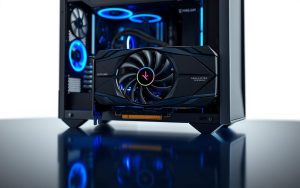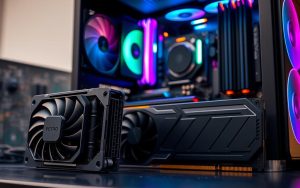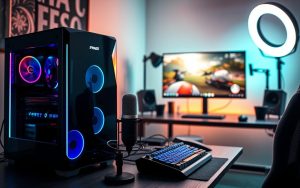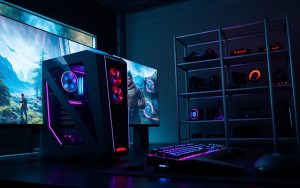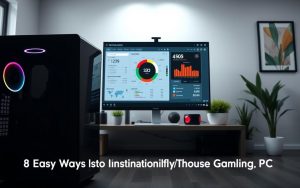Table of Contents
Using a Samsung Smart TV as a display for your gaming setup is becoming increasingly popular. The large screen offers an immersive experience, making it a great choice for modern gamers. With expanded functionality, these TVs can enhance your gaming sessions significantly.
This guide covers both wired and wireless methods to ensure a seamless connection. Whether you’re using HDMI or wireless streaming, the process is straightforward. Modern devices are designed to work together effortlessly, ensuring compatibility across different models.
Key topics include hardware requirements, display optimization, and troubleshooting tips. By the end of this guide, you’ll have everything you need to enjoy gaming on a bigger screen. Let’s dive in and explore the possibilities.
Introduction: Why Connect Your Gaming PC to a Samsung Smart TV?
Large-screen displays offer an unmatched visual experience for modern setups. Whether you’re working or playing, a bigger screen enhances every detail. With 4K and 8K resolutions, every pixel comes to life, making it perfect for immersive gaming and productivity.
Beyond gaming, these displays are versatile. Access Microsoft 365 or other productivity tools directly from your computer. The seamless integration allows you to switch between work and entertainment effortlessly. This flexibility makes it a valuable addition to any home setup.
Compared to traditional monitors, TVs offer superior features like HDR support and built-in sound systems. These enhancements create a more engaging experience. Additionally, remote access capabilities let you control your windows applications from the comfort of your couch.
Smart Monitor models add even more flexibility. They combine the functionality of a TV and a monitor, making them ideal for workspace setups. With a reliable network connection, you can enjoy seamless streaming and multitasking. This makes them a smart choice for both work and play.
What You’ll Need Before You Start
Preparing your setup for a seamless experience requires a few key steps. Ensuring you have the right tools and verifying compatibility will save time and effort. This section covers the essentials to get you started.
Essential Hardware and Software
First, gather the necessary hardware. An HDMI cable is a must for wired connections. If you prefer wireless methods, a stable connected -fi network is crucial. Additionally, check your TV’s USB ports for peripheral connections.
Software updates are equally important. Make sure your TV’s firmware is up to date. This ensures compatibility with newer devices and features. Your computer’s graphics card should also support the desired output resolution.
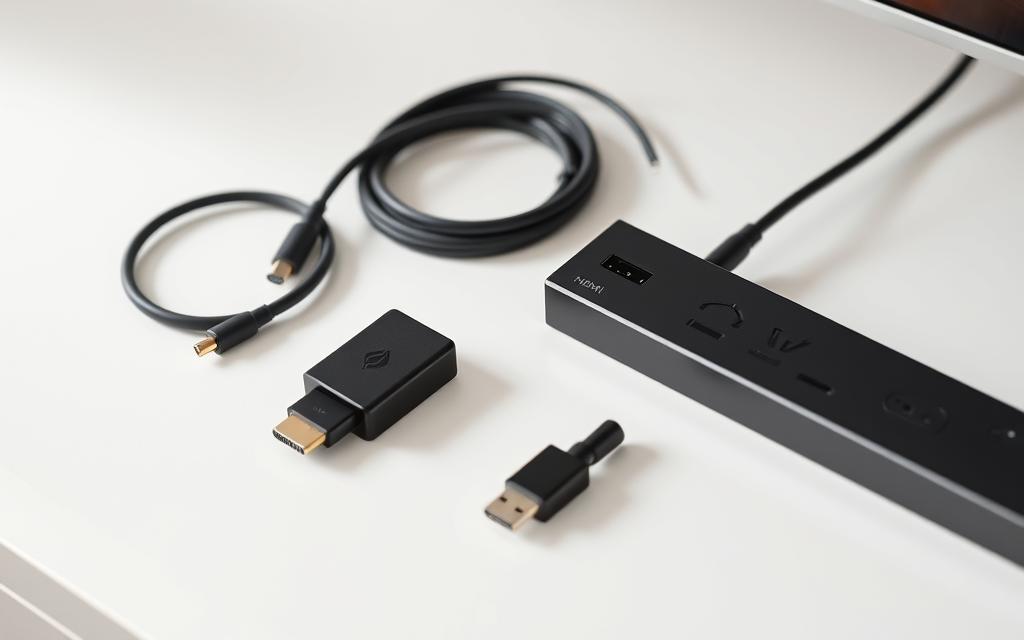
Checking Compatibility
Before proceeding, verify your TV’s HDMI version and HDCP support. These features ensure a smooth connection and prevent display issues. Confirm your PC’s graphics card output capabilities match your TV’s requirements.
Test your network speeds if you plan to use wireless methods. A slow connection can lead to lag or interruptions. For older models, check if they support cross-network connections via updates.
- Verify TV’s HDMI version and HDCP support.
- Check PC’s graphics card output capabilities.
- Confirm TV firmware version meets requirements.
- Test network speeds for wireless methods.
- Identify USB ports for peripheral connections.
By following these steps, you’ll ensure a smooth setup process. This preparation allows you to focus on enjoying your experience without technical hiccups.
How to Connect Gaming PC to Samsung Smart TV: Wired Methods
Wired connections provide a reliable way to link your devices for a smooth experience. These methods ensure minimal latency and maximum performance, making them ideal for immersive setups. Whether you’re a casual user or an expert, wired options deliver consistent results.
Using an HDMI Cable
An HDMI cable is the most straightforward option for a wired connection. Simply plug one end into your computer’s HDMI port and the other into your TV. Ensure both devices are powered on and set to the correct input mode.
For optimal quality, enable HDR in your Windows settings. This enhances color depth and dynamic range, providing a more vibrant visual experience. Most modern HDMI cables support 4K resolution, ensuring crisp and clear display.
Configuring Display Settings on Your PC
Once connected, adjust your computer’s display properties. Use the Win+P shortcut to access projection options. Choose between extending or duplicating your screen based on your preferences.
For advanced users, configure NVIDIA or AMD control panel settings. Adjust refresh rates and test them using UFO test patterns. This ensures smooth performance, especially for fast-paced activities.
- Access Windows display properties via Win+P.
- Set primary or secondary display preferences.
- Adjust color depth and dynamic range for optimal visuals.
- Configure NVIDIA/AMD control panel settings for advanced adjustments.
- Test refresh rates using UFO test patterns.
Wireless Connection Options
Wireless methods offer flexibility for linking devices without cables. These options are ideal for those who prefer a clean, clutter-free setup. With modern technology, you can enjoy seamless integration between your devices.
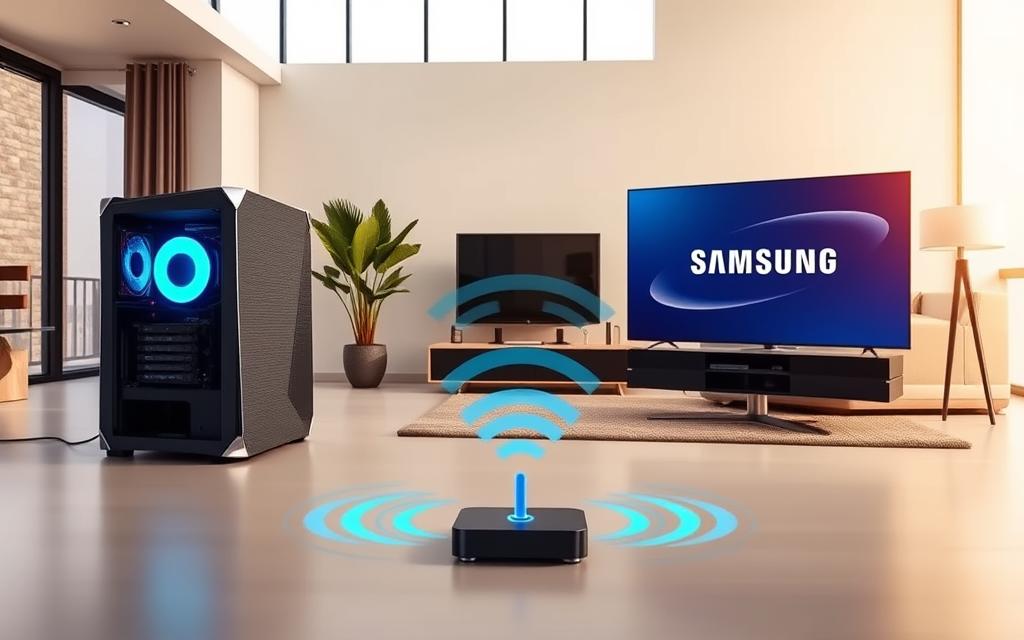
Screen Sharing via Wi-Fi
Screen sharing is a popular wireless option. It allows you to mirror your computer’s display directly to your TV. Ensure both devices are on the same network for a stable connection.
Most Samsung TVs support built-in screen sharing features. Simply enable the function in your TV’s settings and select your computer from the list. This method is quick and requires no additional hardware.
Using the PC on TV App
The PC on TV app simplifies wireless streaming. Download it via smsng.co/PConTV and follow the installation steps. This app is designed to enhance compatibility and ease of use.
Integration with your Samsung account is required for full functionality. Ensure your devices are properly named for easy recognition. This avoids confusion when multiple devices are connected.
- Download and install the app from the provided URL.
- Log in with your Samsung account for seamless integration.
- Use clear naming conventions for device recognition.
- Check firewall settings to avoid connection issues.
- Disable popup blockers to ensure smooth app performance.
While cross-network functionality is limited, the app works well within the same network. Troubleshoot any issues by verifying your browser settings and ensuring your firewall isn’t blocking the connection.
Setting Up Remote Access for Seamless Control
Remote access allows you to control your computer from your TV effortlessly. This feature is ideal for managing tasks without switching devices. Follow these instructions to enable and configure remote access for a smooth experience.
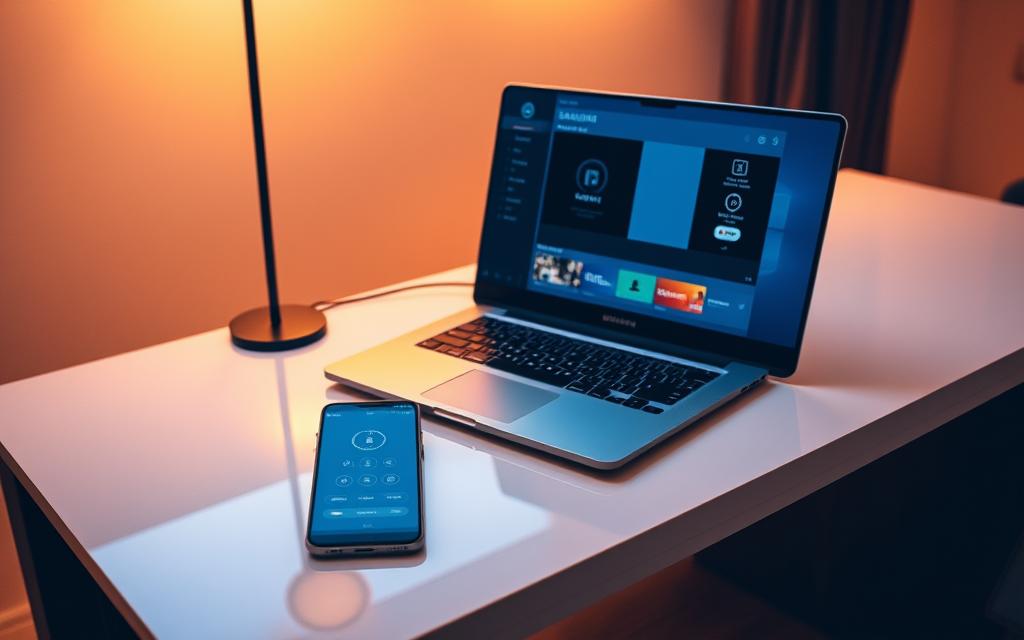
Enabling Remote PC on Your TV
Start by enabling the remote PC feature on your TV. Navigate to the settings menu and locate the remote access option. Make sure your TV and computer are on the same network for a stable connection.
Enter your computer’s IP address and credentials when prompted. This step ensures secure access to your device. Note: Double-check the IP address to avoid errors during setup.
Registering Your Computer
Registration is essential for persistent device profiles. Create a profile for your computer to save settings and preferences. This simplifies future connections and enhances usability.
Follow these best practices for a seamless registration process:
- Use strong passwords for secure access.
- Troubleshoot registration failures by verifying network settings.
- Manage multiple PC profiles for household or office use.
- Enable automatic reconnection features for convenience.
| Step | Action | Details |
|---|---|---|
| 1 | Enable Remote PC | Access TV settings and activate the feature. |
| 2 | Enter Credentials | Input your computer’s IP address and login details. |
| 3 | Register Device | Create a persistent profile for easy access. |
| 4 | Configure Settings | Adjust preferences for optimal performance. |
Optimizing Display and Audio Settings
Fine-tuning your display and audio settings can significantly enhance your viewing and listening experience. Proper adjustments ensure clarity, smooth visuals, and immersive sound, making every session more enjoyable.
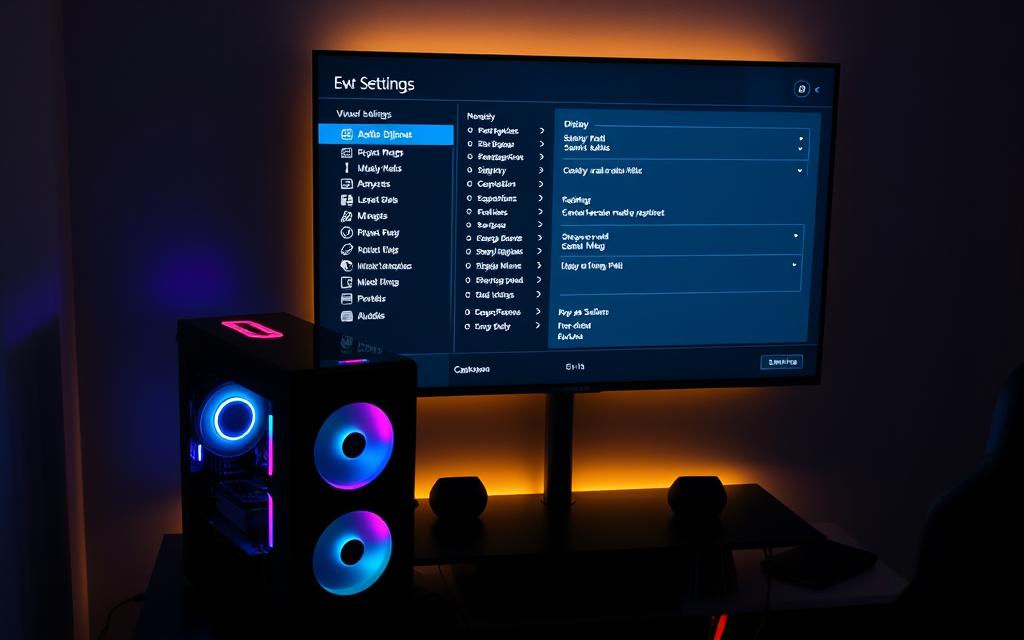
Adjusting Resolution and Refresh Rate
Start by setting the correct resolution for your screen. Higher resolutions like 4K provide sharper images, while a higher refresh rate ensures smoother motion. These settings are crucial for both work and play.
Access your computer’s display settings to make these adjustments. For advanced users, tools like NVIDIA Control Panel or AMD Radeon Software offer additional customization options. Test different settings to find the perfect balance.
Enhancing Audio Output
Audio quality is just as important as visuals. Configure surround sound formats for a more immersive experience. HDMI ARC/eARC connections can simplify audio setup and improve sound clarity.
Bluetooth audio synchronization ensures your sound matches the visuals without delay. Game-specific audio presets can further enhance your experience by tailoring sound to your activity.
- Configure surround sound formats for immersive audio.
- Use HDMI ARC/eARC for simplified audio setup.
- Sync Bluetooth audio to eliminate delays.
- Enable game-specific audio presets for tailored sound.
- Adjust audio delay compensation for perfect synchronization.
| Setting | Benefit | Tool |
|---|---|---|
| Resolution | Sharper images | Display Settings |
| Refresh Rate | Smoother motion | Graphics Control Panel |
| Surround Sound | Immersive audio | Audio Settings |
| Bluetooth Sync | No audio delay | Device Manager |
“Optimizing your settings is the best way to unlock the full potential of your setup.”
By following these steps, you’ll create a seamless and immersive experience. Whether you’re streaming, chatting, or gaming, these adjustments will help you get the most out of your devices.
Using Your TV as a Second Monitor
Transform your TV into a powerful second monitor for enhanced productivity and entertainment. This setup allows you to multitask efficiently, whether you’re working on projects or enjoying immersive experiences. With the right configuration, your TV can serve as an extension of your workspace or a larger display for leisure activities.
Extending vs. Mirroring Your Display
When using your TV as a second monitor, you have two primary options: extending or mirroring your display. Extending your screen provides additional workspace, ideal for multitasking. Mirroring, on the other hand, duplicates your screen, perfect for presentations or sharing content.
To switch between these modes, use the Win+P shortcut on your computer. Choose the option that best suits your needs. For example, extending your display is great for expert users who need more screen real estate.
Gaming Features to Enable
For an optimal experience, enable specific features on your TV. Start by activating Game Mode, which reduces input lag and enhances responsiveness. This is crucial for fast-paced activities.
Other features to configure include:
- ALLM (Auto Low Latency Mode): Automatically adjusts settings for minimal delay.
- HDR10+ Gaming: Enhances color and contrast for a more vibrant visual experience.
- Variable Refresh Rate: Reduces screen tearing for smoother gameplay.
- Motion Interpolation: Improves motion clarity during fast scenes.
These adjustments ensure your TV performs at its best, whether you’re working or enjoying a game.
Troubleshooting Common Connection Issues
Encountering issues during setup can be frustrating, but solutions are often straightforward. Whether you’re dealing with no signal or lag, understanding the root cause is the first step. This section provides practical tips to resolve common problems and get your setup working smoothly.
No Signal or Display Problems
If your TV isn’t receiving a signal, start by checking the physical connections. Ensure the HDMI cable is securely plugged into both devices. Verify that the correct input settings are selected on your TV. Sometimes, a simple restart of both devices can resolve the issue.
For persistent problems, test the HDMI cable with another device. If the cable is faulty, replace it. Additionally, ensure your computer’s graphics drivers are up to date. Outdated drivers can cause compatibility issues.
Fixing Latency and Lag
Latency and lag can ruin your experience, especially during fast-paced activities. Start by optimizing your network for better performance. Prioritize your device’s traffic to reduce delays. Reducing buffer bloat can also improve responsiveness.
Adjusting your mouse polling rate and analyzing frame pacing can further minimize lag. Wireless interference is another common culprit. Ensure your router is placed away from other electronic devices to avoid signal disruption.
- Prioritize network traffic for smoother streaming.
- Reduce buffer bloat to improve responsiveness.
- Adjust mouse polling rates for better control.
- Analyze frame pacing to minimize stuttering.
- Mitigate wireless interference for a stable connection.
By following these steps, you can resolve most issues and enjoy a seamless way to use your devices together. Troubleshooting may take some time, but the results are worth it.
Alternative Methods for Specific Models
Exploring alternative methods can help you achieve compatibility with specific models. Whether you’re working with older devices or non-compatible systems, there are solutions to ensure a seamless experience. This section highlights practical workarounds and adjustments to make your setup work effortlessly.
Chromecast and AirPlay Workarounds
For non-compatible models, Chromecast with Google TV is a reliable option. It allows you to stream content directly from your computer to your TV. AirPlay is another excellent choice for Apple users, offering wireless mirroring with minimal setup.
Make sure your devices are on the same network for smooth operation. These tools are ideal for those who prefer a wireless setup without compromising on quality. They also support high-resolution streaming, ensuring a crisp display.
Older Samsung TV Compatibility
Older Samsung tvs may require additional steps for compatibility. Start by checking the HDMI version and HDCP support. If necessary, use adapters like DisplayPort to HDMI for seamless connections.
Custom resolution forcing can help optimize the display for older models. Adjusting the color space ensures accurate visuals. For remote access, consider legacy alternatives that work with outdated systems.
- Verify HDMI version and HDCP support.
- Use adapters for DisplayPort to HDMI connections.
- Force custom resolutions for optimal display.
- Adjust color space settings for accurate visuals.
- Explore legacy remote access solutions.
By following these steps, you can connect computer systems to older TVs without hassle. These adjustments ensure a smooth and enjoyable experience, even with outdated hardware.
Conclusion: Enjoy Your Gaming PC on a Big Screen
Setting up your computer with a large screen enhances both work and play. By following the steps outlined, you can achieve a seamless experience at home. Optimal configurations ensure smooth performance, whether you’re streaming or multitasking.
Future-proof your setup by investing in reliable hardware and keeping software updated. For multi-user scenarios, consider features like Steam Link’s Remote Play Together. This allows shared enjoyment without compromising quality.
Regular maintenance is key. Ensure your network remains stable and devices are updated. A well-maintained setup guarantees long-term performance and minimizes disruptions.
Finally, fine-tune your settings for the best results. Adjust resolutions, refresh rates, and audio outputs to match your preferences. With these tips, you’re ready to maximize your experience on a bigger display.
For more detailed guidance, check out this comprehensive guide on streaming setups.
FAQ
What hardware is needed for a wired connection?
You’ll need an HDMI cable, a compatible port on both devices, and optionally a keyboard and mouse for setup.
Can I use a wireless method to link my devices?
Yes, you can use Wi-Fi, the PC on TV app, or screen sharing features for a wireless setup.
How do I enable remote access for control?
Enable the Remote PC feature on your Samsung Smart TV and register your computer through the settings menu.
What should I do if there’s no signal on the TV?
Check the HDMI connection, ensure the correct input source is selected, and verify your PC’s display settings.
How can I optimize the display for gaming?
Adjust the resolution and refresh rate in your PC’s display settings to match your TV’s capabilities.
Can I use my TV as a second monitor?
Yes, you can extend or mirror your display by configuring the settings in your computer’s display menu.
Are there alternatives for older Samsung TVs?
For older models, consider using Chromecast, AirPlay, or HDMI adapters to establish a connection.
How do I fix latency or lag issues?
Ensure both devices are on the same Wi-Fi network, reduce background processes, and use a wired connection if possible.
What’s the difference between extending and mirroring the display?
Extending allows you to use the TV as an additional screen, while mirroring duplicates your PC’s display on the TV.
Do I need special software for this setup?
Most connections require only built-in tools, but some wireless methods may need specific apps like the PC on TV app.



